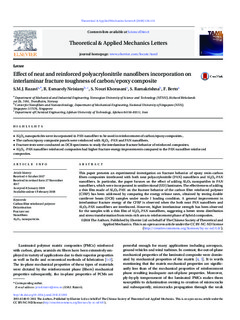| dc.contributor.author | Razavi, Seyed Mohammad Javad | |
| dc.contributor.author | Esmaeely neisiany, Rasoul | |
| dc.contributor.author | Nouri khorasani, Saied | |
| dc.contributor.author | Ramakrishna, Seeram | |
| dc.contributor.author | Berto, Filippo | |
| dc.date.accessioned | 2018-12-11T12:01:30Z | |
| dc.date.available | 2018-12-11T12:01:30Z | |
| dc.date.created | 2018-09-04T11:00:05Z | |
| dc.date.issued | 2018 | |
| dc.identifier.citation | Theoretical and Applied Mechanics Letters. 2018, 8 (2), 126-131. | nb_NO |
| dc.identifier.issn | 2095-0349 | |
| dc.identifier.uri | http://hdl.handle.net/11250/2577115 | |
| dc.description.abstract | This paper presents an experimental investigation on fracture behavior of epoxy resin-carbon fibers composites interleaved with both neat polyacrylonitrile (PAN) nanofibers and Al2O3-PAN nanofibers. In particular, the paper focuses on the effect of adding Al2O3 nanopartiles in PAN nanofibers, which were incorporated in unidirectional (UD) laminates. The effectiveness of adding a thin film made of Al2O3-PAN on the fracture behavior of the carbon fiber reinforced polymer (CFRP) has been addressed by comparing the energy release rates, obtained by testing double cantilever beam (DCB) samples under mode I loading condition. A general improvement in interlaminar fracture energy of the CFRP is observed when the both neat PAN nanofibers and Al2O3-PAN nanofibers are interleaved. However, higher interlaminar strength has been observed for the samples with a thin film of Al2O3-PAN nanofibers, suggesting a better stress distribution and stress transformation from resin-rich area to reinforcement phase of hybrid composites. | nb_NO |
| dc.language.iso | eng | nb_NO |
| dc.publisher | Elsevier | nb_NO |
| dc.rights | Attribution-NonCommercial-NoDerivatives 4.0 Internasjonal | * |
| dc.rights.uri | http://creativecommons.org/licenses/by-nc-nd/4.0/deed.no | * |
| dc.title | Effect of neat and reinforced polyacrylonitrile nanofibers incorporation on interlaminar fracture toughness of carbon/epoxy composite | nb_NO |
| dc.type | Journal article | nb_NO |
| dc.type | Peer reviewed | nb_NO |
| dc.description.version | publishedVersion | nb_NO |
| dc.source.pagenumber | 126-131 | nb_NO |
| dc.source.volume | 8 | nb_NO |
| dc.source.journal | Theoretical and Applied Mechanics Letters | nb_NO |
| dc.source.issue | 2 | nb_NO |
| dc.identifier.doi | 10.1016/j.taml.2018.02.008 | |
| dc.identifier.cristin | 1606504 | |
| dc.description.localcode | ©2018 The Authors. Published by Elsevier Ltd on behalf of The Chinese Society of Theoretical andApplied Mechanics. This is an open access article under the CC BY-NC-ND license(http://creativecommons.org/licenses/by-nc-nd/4.0/). | nb_NO |
| cristin.unitcode | 194,64,92,0 | |
| cristin.unitname | Institutt for maskinteknikk og produksjon | |
| cristin.ispublished | true | |
| cristin.fulltext | preprint | |
| cristin.qualitycode | 1 | |

